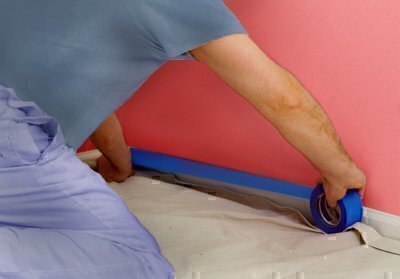Tips on Painting a Room
Last updated June 2021
Repainting is the easiest, most cost-effective way to redo a room’s décor. Before you grab a brush and roller, here are some tips on how to paint like a pro.
 Clear the area. Move everything out of the room, or push it into a pile in the center and cover that with a drop cloth.
Clear the area. Move everything out of the room, or push it into a pile in the center and cover that with a drop cloth.
Minimize cleanup. Tape drop cloths in place so they won’t shift as you work and move ladders. Also, remove light fixtures and electrical cover plates so you won’t have to paint around them or clean them after painting.
Light it up. Flooding the room with bright lighting will make it easier to identify cracks and uneven surfaces, and help you to apply even coats of paint.
Prep the walls. Even the best paint can’t hide obvious defects. How well you fill cracks, scrape, and sand will make or break the job. If drywall seams are cracked or blistered, cut them open, add layers of compound, and sand them smooth. Dig out cracks, scrape flaking paint until you hit solid material, and sand down any hard edges of the old paint surface. Lightly wash all surfaces with a sponge lightly wetted with warm water and a little soap or liquid detergent.
Prime raw surfaces. Cover any spackled areas with a prime coat, brushing out the edges to avoid lap marks later on.
Conceal stains. Coat blemishes such as grease stains and crayon marks with pigmented white shellac (name brands include B-I-N and KILZ). It prevents color from bleeding through the final coat of paint.
Mask edges. Use painter’s masking tape in places where it’s difficult to coat one surface neatly up to, but not onto, another—a skill called “cutting in.”
Keep rooms ventilated. Open windows and run fans to keep air moving; this helps the paint dry and reduces fumes.
Paint in sections. Paint one area at a time—from a corner to a door or window. Cut in the edges with a brush so you won’t have to roll right up to the trim. This speeds paint rolling and reduces lap marks—edges of paint that dry before you get back to them as you continue around the room.
Start high and work down. Start with the ceiling, then crown moldings, then walls, and finally baseboards.
Double-roll it. When painting walls, after cutting in around trim lay a few heavy horizontal swaths of paint onto the immediate work area. As they start to drip, roll out horizontal and slightly angled strokes to spread the paint; then switch to vertical strokes to finish. If there are any drips or laps still showing, repeat the vertical strokes with less pressure, lightly lifting the roller off the wall at the end of each pass to produce an even and continuous coat.


